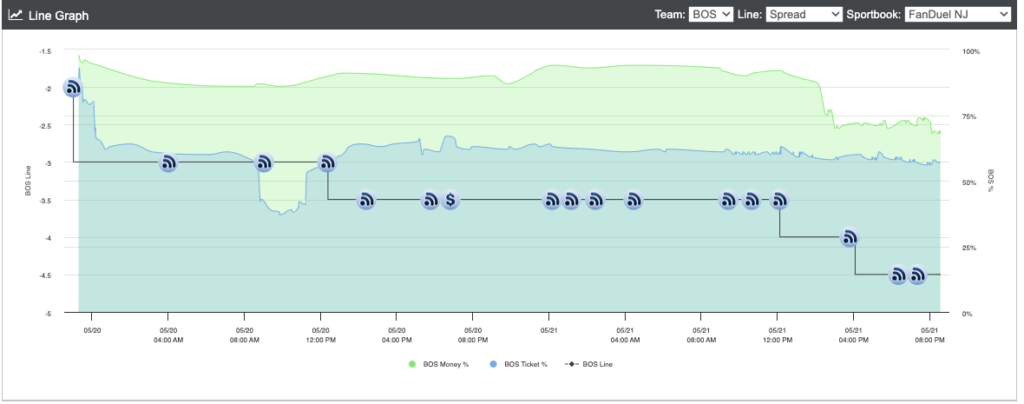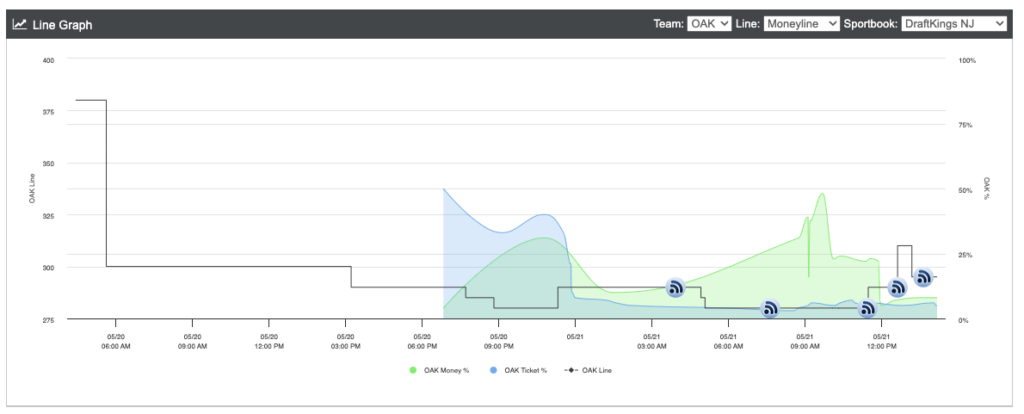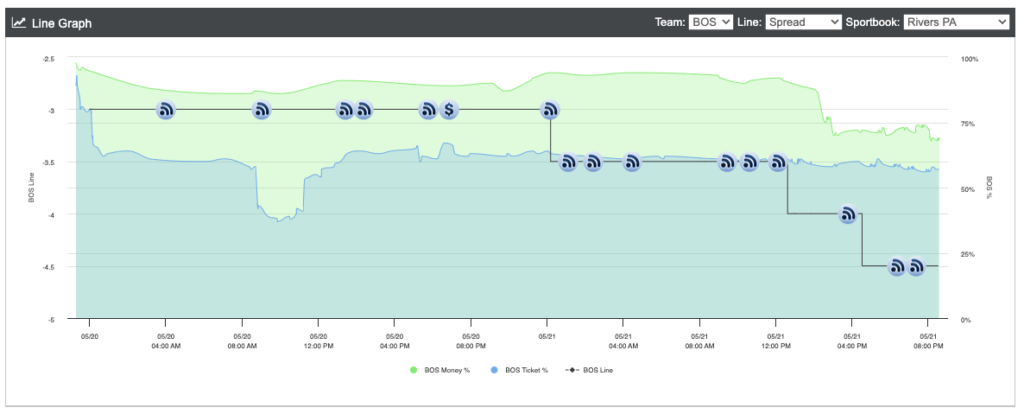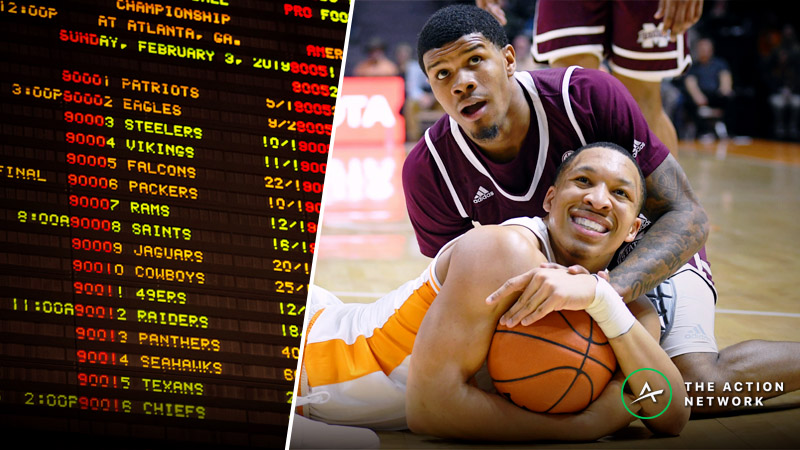How Are Sports Betting Lines Really Made?
Randy Sartin-USA TODAY Sports. Pictured: Tennessee Volunteers forward Grant Williams (2), Mississippi State Bulldogs guard Lamar Peters (2).
There's a common belief among sports bettors that "Vegas knows" or that oddsmakers are mathematical oracles who can predict the exact score of random sporting events down to the decimal point. This is most certainly not the case.
Sports betting odds like point spreads are like any other "market." Betting odds are created through a "wisdom of the crowds" treatment — bettors all around the world buy and sell the line until it reaches the "correct" price. So when you're betting the Chiefs -3 against the Bills, you're also betting against the opinion of thousands of other bettors who have wagered into that line.
In over-simplified terms, there is a four-step process from the creation of each point spread until the game begins.
- A "market-making" sportsbook releases the line first, with low betting limits — depending on the sport, it's likely a few hundred dollars. Most market-making books are not in the United States.
- Bettors wager on those lines, and the prices move quickly. Anyone can bet into these prices, but you have to know which books to wager at and when they open lines to get the most favorable prices.
- Once the price settles, other books across the world copy the spread. They all use an "odds screen" that shows which books have what prices, and they try not to deviate too much from the market.
- The next day or later in the weekend depending on the sport, he market-making books raise their limits, and bettors continue to move the lines until the price reaches an equilibrium and the game begins.
We'll dive deeper into each part of the process below. We'll use the NBA as an example, though the process is similar for other sports, just on a different timeline.
1. The Opening Line
Someone has to come up with the first point spread, right? Oddsmakers at market-making sportsbooks are some of the best in the world.
Nowadays, they use a heavily-statistical approach. All oddsmakers have "power ratings" that project what each team would be against another on a neutral field or court. They then make adjustments based on home-court advantage, injuries, rest, travel situations, current form, and more.
For example, most power rating systems had the Chiefs 2-3 points better than the Eagles entering the 2023 Super Bowl. But the Chiefs probably got dinged a bit for Patrick Mahomes' injured ankle, and the Eagles had dominated both of their playoff games, which is probably why the line ended up at Chiefs -1.5 instead of -2.5 or -3.
2. The Early Action
Once a line is posted, it's time for those sportsbooks to take some action and enter "price discovery." FanDuel is one of the U.S. books that does actually open some lines. They posted Celtics -2 right after Miami beat Boston in Game 2 on Friday night, around 11 p.m. ET.
Immediately, the line moved from Celtics -2 to -3, thanks likely to some quick betting action on Boston, which then slowed once they moved the line to -3. Sportsbooks don't want to get burned by a bad number, which is why they keep their limits low at this stage. You can track granular line movement by book with our Sports Insights Odds tool.

Think about it like this — if 10 respected, sharp bettors thought Celtics -2 had value and FanDuel let them bet $10,000 each on it, they'd probably bet $10k a piece.
So FanDuel would learn that -2 was too short, and move to -3, but they'd be on the hook for $100,000. So instead, they keep the limits low, and a book can learn that -2 was too short while only being on the hook for $5k.
If those same bettors though Celtics -3 was too short, they likely would have continued betting until it moved to -4 and beyond.
That's what happened in this A's vs. Astros game. DraftKings opened at +380, but the early action on Oakland was likely overwhelming enough to drop it immediately to +300.

3. The Copy/Paste
OK, back to the NBA. Once the line started to settle at Celtics -3 and there wasn't much movement from 11 p.m. to 12 a.m. ET, other books now feel comfortable copying it. Basically, they now know that they won't be vulnerable to early bettors picking off a bad price.
You can see that an hour after FanDuel opened, around midnight ET, BetRivers posted Celtics -3.

You can also see that pretty much in stride over the next two days, BetRivers moved its numbers in a similar pattern as FanDuel, particularly on the day of the game. Is that because both books were getting one-sided action on the Celtics at the same time? I don't think so.
This tactic is called "moving on air" — the idea that sportsbooks only move their lines when other books move theirs, not as a result of any actual, significant betting action as you'd expect. There is something called "steam" — a drastic and uniform line movement across the entire sports betting marketplace. It can either be the result of a betting group placing many bets all at once, or many bettors chasing a line move after it happened at another book. Though nowadays, I'd guess these moves are mostly books moving on air.
4. Raising Limits
Depending on the sport and season, there are different time periods when books raise their limits. In the NFL, odds tend to open up Sunday, and have limit increases throughout the week until a key increase on Thursday.
That's when you'll see some of the world's best bettors wager into these markets and make their opinions known, resulting in key line movement. For them, betting at low limits when the lines open aren't worth it.
In the NHL and NBA regular season, most books will open up lines for Tuesday's games on Monday night, and then increase their limits sometime in the late morning.
Back to the FanDuel example. With the limits higher on game day, FanDuel moved from Celtics -3.5 to -4 at noon ET, then from -4 to -4.5 a few hours later.

Is the Process the Same for Props?
For props, there isn't as much "price discovery" because the limits are lower. But there are still ratings and projection systems that books use to spit out a number. And as they get action on those props, they move them. Books will also copy movement at other sites.
Generally, U.S. books manage risk on props by 1) banning bettors who pick off bad numbers and 2) increasing the margin so that even if you know what you're doing, it's hard to overcome the house edge.
Sportsbooks have a much larger "attack surface" than bettors because in theory, they have to accept bets on what they post. You as the bettor do not have to bet everything. And the books simply don't have all the same info as a bettor specializing and studying only Euro Tour golf matchups.
That's why books offer props with 30-cent (-115/-115) or even 40-cent lines (-120/-120) instead of -110 at both sides. They know they might get beat by bettors who know these markets inside and out, but their margin is high enough to win in the long run.
How would you rate this article?




